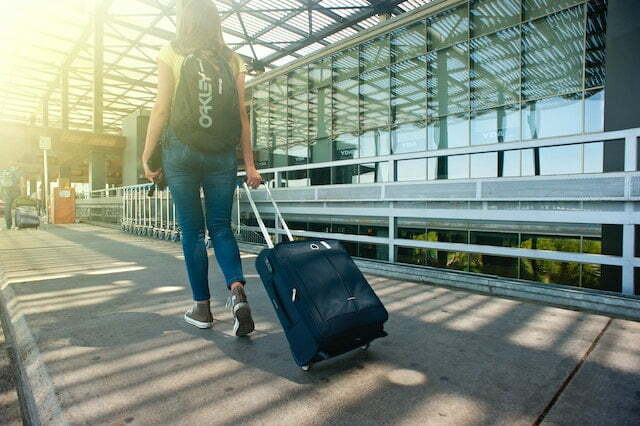It’s travel time again when the weather is warm and people are gearing up for their summer travels. While summer is an excellent opportunity to explore new destinations and hit the beach, it also comes with the challenge of packing. To avoid back injury, learn how to carry heavy luggage safely.
Carrying heavy and bulky luggage can increase your risk for neck, back, and shoulder injuries. In addition, it can strain your muscles, bones, and joints, making it difficult for you to move around.
Moreover, some airlines charge passengers for checked baggage, which is why many travelers carry over-packed carry-on bags, putting themselves at risk of injury by lifting them into the overhead compartments.
In this article, we’ll explore some tips to avoid back injury while carrying your travel essentials.
Last-minute holiday hotel deals
Avoid Back Injury: Carefully Plan What You Pack for Your Trip

Before lifting anything, consider the following factors: the duration you’ll be holding the object, whether you need to take a break to readjust your grip, and where you’ll be placing the heavy item.
Ensure that the path is clear of any obstacles before you begin, and consider using a trolley or asking for assistance from another person when lifting heavy luggage. Wear comfortable clothing, allowing for easy movement.
Remember to wear practical footwear too. Take your time and slowly move while paying attention to your actions. It’s crucial to assess your ability to lift an object; just because you can lift something doesn’t mean it’s safe. Only attempt to raise things that you can handle easily.
Save on Travel with Trip.com (ENG)
Use a Light Bag with a Handle and Wheels

Avoid lifting heavy objects altogether. Even if you don’t need to place it in your vehicle, carrying it can be strenuous. To make your travels more comfortable, consider using luggage with wheels to pull your suitcases behind you. It will alleviate pressure on your back and make your journey more manageable.
For smaller carry-on bags, choose an oversized purse with thicker straps. Thin straps can dig into your shoulder, resulting in muscle and skin discomfort when the bag is full. Wide straps will distribute the weight more evenly, ensuring a more comfortable experience.
Avoid Back Injury: Ensure Good Posture

It’s crucial to maintain the proper posture while lifting things. Start by standing tall with your chin slightly tucked in and your shoulders relaxed. Next, ensure your knees are loose, and your spine is naturally curved. Next, keep your ears, shoulders, hips, and ankles aligned straight. Finally, stand with your feet apart and one foot slightly forward to maintain balance.
Safely Lift Your Luggage

When lifting heavy luggage in and out of your car’s trunk, it is crucial to practice caution. Always lift from your legs and not your back to avoid injury. Keep a straight back and bend at the knees while picking items up from the ground. Furthermore, it prevents twisting while carrying your bags. Instead, move your feet when you need to turn.
Engaging your deep abdominal muscles by gently drawing your belly button towards your spine is essential when lifting something. Holding the thing close to your body and carrying the heaviest part of it close to your body can also help.
To avoid back injury, maintain proper posture while lifting any object. Keep the alignment of your shoulders and hips. Avoid any back twisting. Instead of moving your body, move your feet to adjust your position. Keep your head up and face forward while making smooth movements. Avoid abrupt jerking movements at all times.
Safely Put Your Luggage Down

When putting down objects, it’s essential to do it safely. You can do this by reversing the process you used to pick it up. Start by keeping the thing close to your body, engaging your tummy muscles, and bending your knees. Try to avoid twisting while putting it down. Ideally, you should place the object on a surface that’s at waist height, such as a table.
To ease the burden on your body, use every chance to put down your luggage when you’re not in motion. It could be while waiting for a security check at the airport or riding an elevator. However, it’s essential to use your leg muscles and not your back when lifting it again.
Switch Holding Your Luggage

Consolidating items into a single carry-on bag is a popular method. You can stuff the carry-on bag to ensure everything fits in one bag. However, if you carry a shoulder bag, you should alternate the shoulder you use. It will help to prevent putting excessive strain on one side of your back throughout your journey.
Top Tips to Avoid Back Injury While Dealing With Your Luggage

When selecting a suitcase for your travels, avoid purchasing a heavy one, even when it’s empty. Instead, opt for a case with wheels and an extendable handle, making it easier to pull rather than lift.
Look for padded straps for backpacks and wear them on both shoulders instead of just one. When packing your bag, placing heavier items in the center and at the bottom is best to distribute the weight evenly.
Are you going anywhere anytime soon? Check the lowest flights below.
Final Thoughts
Carrying heavy luggage can lead to neck, back, and shoulder injuries. In addition, the weight of the bags can exert pressure on your muscles, joints, and bones, causing strain. Avoid back injury by following the mentioned tips for a safe and fun traveling experience.

Pingback: January Festivals in the Visayas Worth the Fun - Hop 'N Cruise